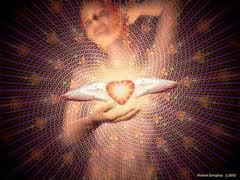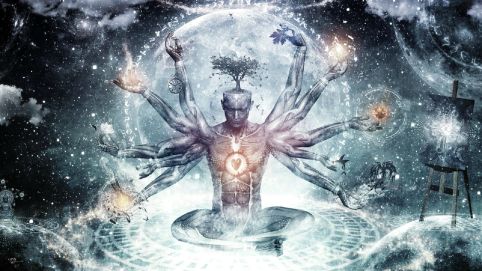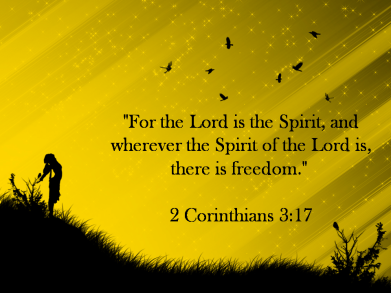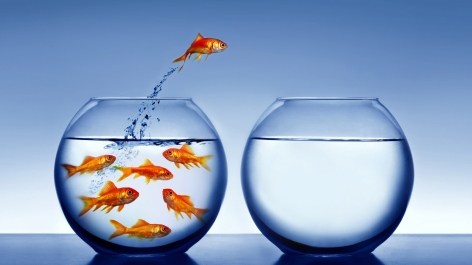Cynthia Bourgeault: ‘Seeing With The Eyes Of The Heart’

Finally, I have created the time to write the blog post I have been intending to write for a while.
I have been very busy in the last few months with the work of the nonprofit, Alianza Arkana, I help lead here in Pucallpa, in the heart of the Peruvian Amazon.
As always, the work has been challenging, complex, intense, absorbing and satisfying.
This blog post grew out of the proddings of a good friend who has been regularly sending me material related to what can be called the Christian Wisdom tradition, as exemplified in the work of Teilhard de Chardin and Dr Cynthia Bourgeault. A few weeks ago, I watched the video on YouTube with Cynthia Bourgeault being interviewed by Renate McNay, on the Conscious TV channel.
I can’t recommend this video highly enough. You need 55 minutes of quiet time to watch and absorb it, and another ten minutes to do the suggested meditation at the end.
The video is packed with insights. Although Cynthia Bourgeault is talking about her own spiritual path within the Christian Wisdom tradition, which encompasses Quakerism, being ordained as one of the first women Espiscopal priests in 1979, ten years of study within the Gurdjieff tradition, and regularly spending three months a year in solitude, what she says is extraordinarily relevant for those of us who have chosen the medicine path. Watching the video, too, and hearing Cynthia B. talk about embodiment, it is clear that she is a beautifully embodied example of what she is talking about. Her integrity, wisdom and faith shine through.
For me, particularly, what she says at the beginning of the interview about her spiritual choices being limited in a childhood spent in the 1950’s in Pennsylvania with Christian Scientist parents resonates strongly with my own experience of growing up in suburban London with agnostic parents in the 1950’s and 1960’s.
I was blindly searching for something that I could not find in the local Baptist Church that I attended as a child, nor, in my adolescence, with the charismatic Anglican vicar that many of my school friends turned to. But, as Cynthia Bourgeault says in the interview, we are born into a time and destiny that shapes and restricts us. Also, if we accept ideas of reincarnation, we choose the times and family we are born into. Listening to her helps me recover and revalue this early religious experience.
For the remainder of the post, I want to pick out a number of themes from the interview that especially resonate with my experience of La Madre Ayahuasca.

Image found at: http://www.thewayofmeditation.com.au/blog/6-things-you-lose-as-a-result-of-spiritual-awakening/
1. Awakening
For many of us drinking ayahuasca, the experience is an awakening. (I have touched on this before).
This awakening can be at many levels. At a personal level, similar to undergoing therapy, where we realise how our personality and the psychological issues we face have been shaped by our upbringing. At a spiritual level, where we are graced with profound experiences of other realms that can encompass the full range of different spiritual traditions – in Jungian terms, we gain access to the vast repository of the collective unconscious. And, at an ecological and even political level, where we experience the interconnectedness of life, the ways that the fabric of life on the planet is being degraded, and, hopefully, a desire to do something about this. La Madre also shows us that these are not separate but deeply intertwined levels.
Cynthia Bourgeault refers to how her ten year study within the Gurdjieff tradition, and the practice of the body movements that Gurdjieff recommended, followed by the practice of ‘centering prayer’ she learnt from her teacher, the trappist monk Thomas Keating, led to her own awakening and liberating from what she describes as: “the vast maze of automatic, programmed behaviors that keep us chained at a lower level, which does not represent real human freedom.”
Later in the interview, she has some very interesting things to say about the process of freeing oneself from these automatic, conditioned patterns. The first step is awareness of them. But, as one hundred plus years of pyschology have shown, just attaining awareness does not necessarily lead to change, though it is probably an indispensable step on the path to change. Then follows the difficult, uncomfortable stage of living in the gap created of being aware of the ways we habitually respond but being unable to free oneself of these limiting patterns.
She talks about the need to patiently live in this gap and bear it and eloquently describes this process as “painfully bearing the crucifixion of inner honesty”. I’m sure this process will be familiar to those of us who have dieted Noyarao, which is described as the ‘camino de la verdad’ (the path of truth). This process can often referred to as “a difficult ceremony” 🙂
As we become more capable of living in this gap, we slowly – and the point is that it is a slow process – we start to identify with and potentiate a greater self rather than the smaller ‘ego’ self. She refers to the slow realization of the greater self as the accumulation of being. In a later part of the interview, she beautifully describes ‘being’ as “the expanded capacity for restful presence in the larger field of the now”. This reminds me of the state of being I can sometimes achieve for short periods towards the end of a ceremony.
2. Freedom and Enlightenment
Cynthia Bourgeaut sees freedom as essentially being freedom from this false, socially programmed self. She approvingly quotes A.H. Almaas – and this quote seems especially relevant now with the kind of freedom being advocated by Donald Trump – that:
“Freedom to be your ego is not freedom. That is slavery. You are just being pulled around a bullring with a ring in your nose.”
She goes on to say that true freedom consists in beng able to follow “the homing beacon of your inner calling”. Paradoxically, only in obedience and perfect service to this deeper calling can we achieve real freedom. She points out that the roots of the word ‘obedience’ actually mean to listen deeply.
I have found in my medicine path that after many years of sturm and drang, the fireworks of visions, and wandering the endless labyrynth of my psyche, I am now being asked to concentrate, to observe and to listen. For a while, I have been told to wait in the gap and my most recent teachings – where I have been given some very direct, concrete specific instructions – have been about the need for patience.
There is a saying in Peru that: “Con paciencia se gana la gloria”. I now understand that on a much deeper level than before. In one ceremony, I was shown all the ways that my impatience limits me and makes me much less intelligent and effective, as well as a much less compassionate human being. To close this particular phase of teachings, I was also told that I would very soon be encountering some major tests of my patience. That has indeed been proved to be the case.
3. ‘We are put on this earth a little space that we might learn to bear the beams of love.’ William Blake
The last part of the interview was music to my ears as it resonates so strongly with the work of my intellectual mentor and hero, James Hillman. Cynthia B. points out that we need to move beyond individualistic ideas of spiritual development (such as the lone goldfish in the image above) – not my enlightenment, nor my self realization.
As I heard James Hillman memorably and provocatively say in a series of lectures about alchemy to a live audience: “Who gives a fuck about your soul?” For Hillman, what was more important was the soul of the world, the anima mundi, which does not exclude our individual souls but also includes the souls of animals, birds, insects, reptiles, plants, trees as well as supposedly inanimate objects like rocks and even plastic cups.
Cynthia B. states that as we become more capable of entering realms of greater being and deeper compassion, we enter a more collective, transpersonal realm. We realise that the force of love is what holds together the fabric of the world, and that, in her terms, this ‘heart-space’, where we may be graced with an encounter with divine love, is a communal not an individual form.
It really seems that this is the challenge we have now facing us a species – to be able to manifest divine love, including being able to bear the pain, sorrow and suffering of God and the planet – not solely for our own enlightenment but for the collective soul of the world, which includes the non-human as well as the human world.
As Michael Meade wrote in conclusion to his brilliant short essay on the day of Trump’s inauguration:
“The fact that love is greater than hate is all that tips the balance of the world towards life. But only if enough people, young and old, find the love and courage in their hearts to truly change the world. This is the time for older people to act like elders and for younger people to stand for the dream of the earth and the beauty of the world.
This is no time for cynicism or giving in to despair; this is the time we have come to life to live, the time to work for what we truly love. As the African proverb insists, “what you love is the cure.” What we love is the cure for what ails us and what brings healing to the human heart also helps heal the world.”
ADDENDUM. Cynthia Bourgeault is offering two online courses related to her work. More details here.


